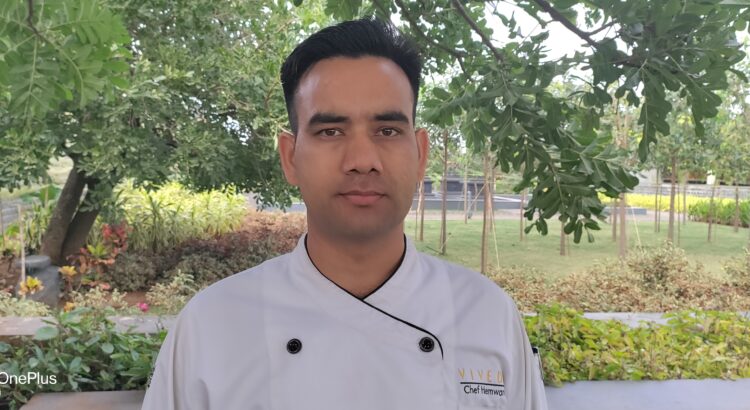In conversation with Chef Hemwant Rautela, Executive Chef at Viveda Wellness Village, Nashik on how he has adapted Sattvic principles into international cuisine
While on the threshold of choosing a career, Chef Hemwant Rautela found cooking very interesting and enjoyable. After completing his Bachelors in Hotel Management, he got to work with various reputed brands in the hospitality industry like Taj, Radisson Devi Garh, Evolve and Carnival Cruise.
 Currently, as Executive Chef at Viveda Wellness Village retreat in Nashik, he has adopted a sattvic style of cooking in keeping with the tenets of the wellness retreat into world cuisine.
Currently, as Executive Chef at Viveda Wellness Village retreat in Nashik, he has adopted a sattvic style of cooking in keeping with the tenets of the wellness retreat into world cuisine.
For a professional, adapting the much less explored Sattvic cuisine could have been risky. But, Chef Hemwant feels when one has passion to learn and imbibe more about this cuisine, one can excel in it too. So, when he got the opportunity at Viveda, he grabbed it and today, he wields his magic wand to innovate and come up with Sattvic food that is delicious and pans across the various cuisines including the global ones. Sattvic cuisine demands exclusion of onion and garlic and Chef Hemwant has mastered this art and applied it to international dishes without compromising on the taste and flavours.
 Here are some of the multicuisine dishes from his menu at Viveda Wellness Village –
Here are some of the multicuisine dishes from his menu at Viveda Wellness Village –
Salads: Som Tam, Khamang Kakadi, Corn Chaat, Black Eye Bean Salad.
Starters: Soya Vegetables, Golden Corn, Kebabs, Sesame Potato.
Soups: Lentil and Coconut Soup, Citrus and Cilantro Soup, Roasted Pumpkin Soup, Broccoli and Almond Soup.
Main course: Makai Palak, Whole Wheat Pasta, Adraki Aloo Gobi.
Dessert: Ragi Lapsi, Foxtail Millet Kheer, Black Rice Kheer,
Herbal Smoothie and Kadha
He shares his experiences of creating Sattvic menu at Viveda, “I got the chance to work as a pre-opening team for Viveda with our General Manager Dr Rejith Daniel. We started Viveda from the scratch and now our guests are appreciating our concept and food. I still remember those days when we passionately worked with the project and department setups and succeeded in its popularity.
 Excerpts from an interview:
Excerpts from an interview:
Why Sattvic food and what is your definition of it?
As a human being sattvic is the best and sustainable way to eat food and to live our life in such a manner where we do not harm other creatures for our food. We must eat as per our body requirements, not just for taste. My definition of sattvic food is honest and wholesome food.
What are your memories of the food you tasted in your childhood and as you grew up?
I belong to a village named Pinoli in Almora district, Uttarakhand, India, where food is grown organically. We used cow dung for fertiliser and I have ploughed fields too. Many indigenous grains like Finger millet, Foxtail millet, Black Eye bean, Red lentil, Black bean, Soya bean, Red rice are grown along with seasonal vegetables too. My family continues to do organic farming. I have grown up eating the food grown naturally.
What are the key ingredients that are a must in your Sattvic menu?
Use of organic and fresh ingredients is the key to sattvic cooking. In my kitchen food is freshly prepared with less spices.
Can you name some of the main course international preparations that you have adapted to sattvic form of cooking on the menu at Viveda?
Beetroot and Spinach Risotto, Sattvic Thai Curry, Soba Noodles, Whole Wheat Pasta, Rice Sheet Cannelloni, Baked Spinach and Corn are few of the dishes we make for main course. Our guests at Viveda are people, who are exposed to global cuisine, and they wholly appreciate and relish our dishes. Especially those who are here on month-long treatment with therapies; they find the food very beneficial. At the same time the wide repertoire of Indian and global dishes makes it an interesting and tasty food experience.
 Can you explain to us how you incorporate international taste into Continental and Pan Asian cuisines without onion and garlic?
Can you explain to us how you incorporate international taste into Continental and Pan Asian cuisines without onion and garlic?
While you are choosing a certain type of lifestyle like sattvic then of course you will not go for just the taste of the food but you will see the effect of what you are eating on your body. Food can be tasty without using onion and garlic too. Using fresh ingredients and cooking it freshly will add the taste. Asafoetida, fenugreek, lemon grass, ginger and many such ingredients can be substituted for onion and garlic.
What are your personal favourite dishes?
Laheshu Roti (whole wheat dough stuffed with ragi) is the specialty of my region. I relish Ragi Lapsi that my mom used to cook for me in my childhood and she still does. Jaggery is one of my favourite ingredients that I used to have with milk in my childhood. Subji of Mustard leaf in Besan is my favourite. Red Lentil & Coconut Soup, Corn & Cucumber Salad are some of the healthy foods I always look up to. And I love international food too.



 After having worked in the capacity of a professional chef handling different positions with hotels and restaurants, Ed Harris discovered Veganism. This happened over a documentary watching session with wife and kids. After watching the famed documentary ‘What The Health’, popular chef, food consultant and author Ed Harris turned into a vegan. From the past few years, the Atlanta-based Chef has been advocating veganism, creating recipes and has turned an entrepreneur with ‘knifenspoon’ brand of food products. While he continues to experiment and innovate to create new products and recipes, he majorly invests his time in advocating veganism. He finds his Guyanese roots enriching and he loves to explores various cuisines on his quest for newer dishes.
After having worked in the capacity of a professional chef handling different positions with hotels and restaurants, Ed Harris discovered Veganism. This happened over a documentary watching session with wife and kids. After watching the famed documentary ‘What The Health’, popular chef, food consultant and author Ed Harris turned into a vegan. From the past few years, the Atlanta-based Chef has been advocating veganism, creating recipes and has turned an entrepreneur with ‘knifenspoon’ brand of food products. While he continues to experiment and innovate to create new products and recipes, he majorly invests his time in advocating veganism. He finds his Guyanese roots enriching and he loves to explores various cuisines on his quest for newer dishes. Do share your process of creating recipes?
Do share your process of creating recipes? Give us more details on your latest cookbook?
Give us more details on your latest cookbook?
 On Pack Protein Claim
On Pack Protein Claim